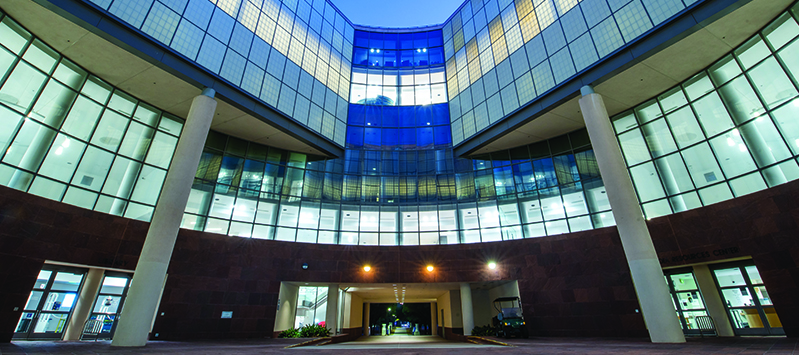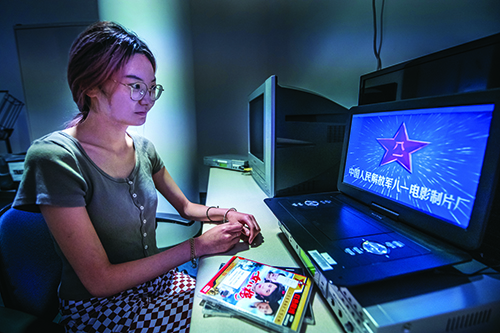
Multimedia Resources Center Serves as a Lifeline for Course Materials
At the base of the newly renovated UCI Science Library sits the Multimedia Resources Center (MRC), an all-access collaborative space and technology center for UCI students and researchers, regardless of major or discipline.
The MRC lends technology such as laptops and cameras to students at no cost. It also gives students and faculty access to multimedia equipment, VR technology, and 3D printing and scanning.
Angeles Teresita Espinoza (BA ’23), a student worker in the MRC who is double majoring in public health policy and anthropology, says the center is multifunctional. According to Espinoza, most students come to the MRC for time-sensitive, course-related needs.
“They are under pressure: ‘I have a midterm tomorrow and I really need a laptop,’ or ‘I have a project that requires a camera,’” says Espinoza. “Some students use our equipment to record a lecture for a teacher.”
In addition to lending devices that students need to complete assignments, the MRC is home to the UCI Libraries' primary collection of digital media and audio-visual materials, including Blu-rays, DVDs, VHS tapes, and CD-ROMs. Even more importantly, it maintains the equipment needed to watch the films in these formats.
A PRECIOUS RESOURCE

course-related media
Bert Scruggs, an associate professor in the Department of East Asian Studies, is a frequent user of UCI Libraries' Chinese-language documentaries and nonfiction films. Scruggs uses the films to illustrate readings in classes.
“Although I have some film majors in my courses, a lot of my students are STEM [science, technology, engineering, and mathematics] and social science majors with an interest in film,” says Scruggs. “The MRC and Libraries film collection brings the course topics to life for my students, more so than simply reading dry text.”
One course Scruggs teaches covers the Japanese colonization of Taiwan between 1895 and 1945. Using titles in the MRC collection, his students can compare and contrast propaganda films made by the Japanese in the 1930s with Taiwanese films produced about the period 70 years later. Scruggs says the UCI Libraries collection lets his students see through the eyes of Japanese and Taiwanese, rather than through an American lens. The different perspectives show how people now remember the period 90 years ago.
Because so many of the titles he needs for his courses are no longer available for purchase and are out of print, Scruggs explains that the UCI Libraries media collection and equipment is becoming increasingly precious.
Often, only the films considered to be of interest to a broad American audience are released with subtitles in the United States. It’s a market-driven decision that excludes most non-English documentaries and other nonfiction films, such as the Chinese and Taiwanese titles he uses to help illustrate the topics in his courses.
A RACE AGAINST TIME
From an educational perspective, Scruggs says the UCI Libraries collection gives an invaluable range of perspectives. It includes Chinese cinema made for Chinese audiences, not just what international distributors think will appeal to American audiences.
Building and maintaining such a collection is not always an easy task, however. Scruggs explains that it is a race against time to acquire films before they go out of print and to digitize VHS tapes before they degrade.
MRC Manager Jose D. Perez says that the media is acquired by UCI librarians, and the librarians and staff work together to preserve the collections in collaboration with private sector vendors.
“Without the UCI Libraries collections, I wouldn’t be able to show these films to my students,” says Scruggs.
A PLACE TO GATHER
According to Scruggs, another key feature of the MRC is its collaborative spaces. He recommends that his students take advantage of the MRC’s group screening rooms.
“A big part of class is having the group experience,” he says. “The MRC makes it possible for student groups to watch the films together and talk about them after.”
While Scruggs’ students are in the MRC they may explore the 3D printers or use the music equipment when they have a break in between classes or to destress with a friend.
Perez says that, although UCI students may first come in on a time-crunch or for course requirements, once they learn about the MRC, they often return to explore its other resources.
“A lot of students are becoming more interested in our 3D printing process. A whole range of different years and different majors are intrigued and looking to see different possibilities,” agrees Angeles Teresita Espinoza. “The MRC has so much to offer.”
To learn more, visit the UCI Libraries webpage for MRC hours, services, and resources.

